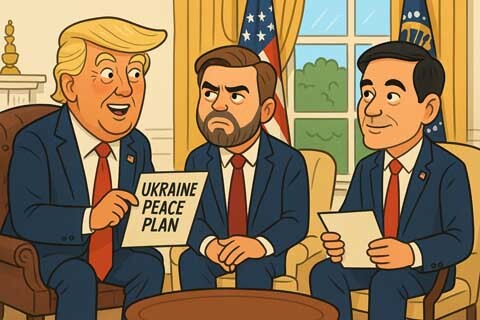 News Staff
News Staff![]() -
Nov 24 -
JD Vance
Marco Rubio
Ukraine-Russia Peace dance
Geneva
-
187 views -
0 Comments -
0 Likes -
0 Reviews
-
Nov 24 -
JD Vance
Marco Rubio
Ukraine-Russia Peace dance
Geneva
-
187 views -
0 Comments -
0 Likes -
0 Reviews

DLNews
Inside the Geneva Shuffle: Peace Plans, Power Plays, and the Quiet Race for Trump’s Ear
Washington/Geneva – Behind the polished handshakes, late-night negotiations, and carefully worded diplomatic statements, something much more human is unfolding in the effort to end the war in Ukraine: ambition, rivalry, and the ever-present hum of American presidential politics.
After hours of intense talks in Geneva, U.S. and Ukrainian negotiators produced a new 19-point document aimed at halting the conflict. It’s slimmer and more cautious than the earlier 28-point proposal that caused outrage in Kyiv — so much outrage, in fact, that Ukrainian officials reportedly asked for coffee stronger than diplomacy itself.
But even as negotiators worked through territorial questions, security guarantees, and the delicate dance of U.S.–Ukraine relations, a quieter drama simmered offstage. Because in Washington, no major foreign-policy moment happens without someone trying to shape the narrative… or secure their future.
At the center of this political tug-of-war are two of President Donald Trump’s most influential lieutenants: Vice President JD Vance and Secretary of State/National Security Advisor Marco Rubio. One is openly ambitious. The other, increasingly influential. And both now find themselves indirectly tied to how this new Geneva plan is received.

Vance immediately embraced the peace push, designed in part by Trump’s special envoy Steve Witkoff together with a Kremlin adviser. Rubio, wary at first, stepped in later — ultimately taking the lead in explaining and adjusting the plan with European and Ukrainian partners. In foreign policy terms, that’s like being handed the steering wheel because someone needs to drive with both hands on it.
Europeans lean naturally toward Rubio, a long-time critic of Vladimir Putin and defender of transatlantic ties. Moscow’s commentators, meanwhile, have praised Vance for his “constructive line,” which is diplomatic shorthand for “he says things we can work with.” A pro-government Russian paper even painted the Vance–Rubio split as a full-blown political standoff, complete with talk of rival “parties” inside the White House orbit.
Back in Washington, Rubio’s rise is being noted. His return to the center of negotiations — especially after the tense Trump-Putin meeting in Alaska — signals that he is gaining ground in shaping U.S.–Russia policy. A senior official from Trump’s first administration put it bluntly: “Now we see Rubio holding talks with Ukrainians and Europeans in Geneva. That’s a good thing.”
Vance, however, is playing his own long game. According to one insider, “he wants one thing above all: to become president.” He is navigating the peace talks with an eye on the MAGA movement, the 2028 landscape, and his place in it. His strategy is simple: support Witkoff so long as Witkoff remains Trump’s favored envoy — and keep Rubio close enough to publicly call him a “best friend,” just in case a future ticket needs balance.

Meanwhile, Ukrainian President Volodymyr Zelenskyy and President Trump are expected to make the final decisions on the most sensitive points — territory, long-term security, and the future of NATO’s relationship with Kyiv. Both sides insist the talks are serious and urgent, even if the path forward remains tangled.
In the end, the new 19-point plan may or may not become the roadmap to peace. But it has already achieved something uniquely American: it turned a high-stakes diplomatic negotiation into a backstage political drama, complete with shifting alliances, unexpected opportunities, and two ambitious contenders quietly preparing for the next chapter.
Because in Washington, peace may be the goal — but power is always part of the conversation.

At Desert Local News, connections are everything. We're not just another social networking platform—we're a lively hub where people from all walks of life come together to share stories, spark ideas, and grow together. Here, creativity flourishes, communities grow stronger, and conversations spark global awareness.